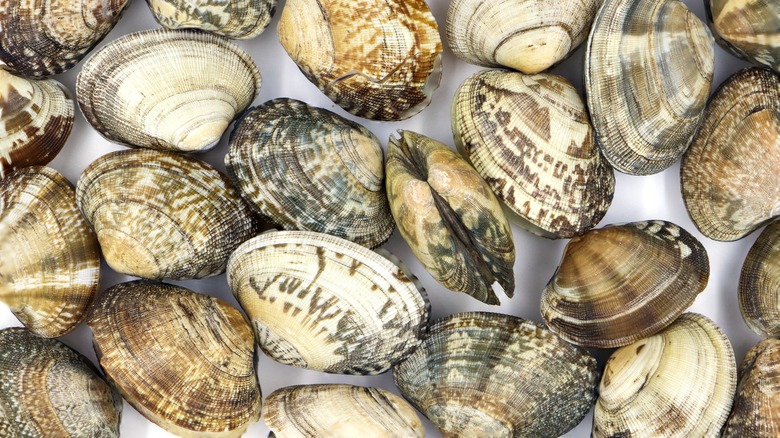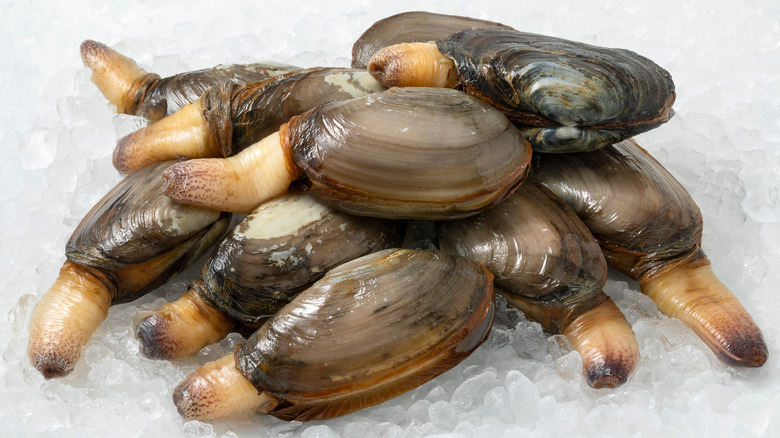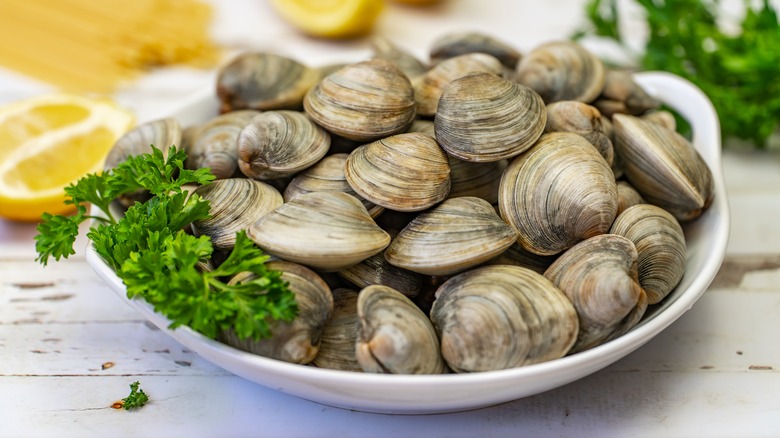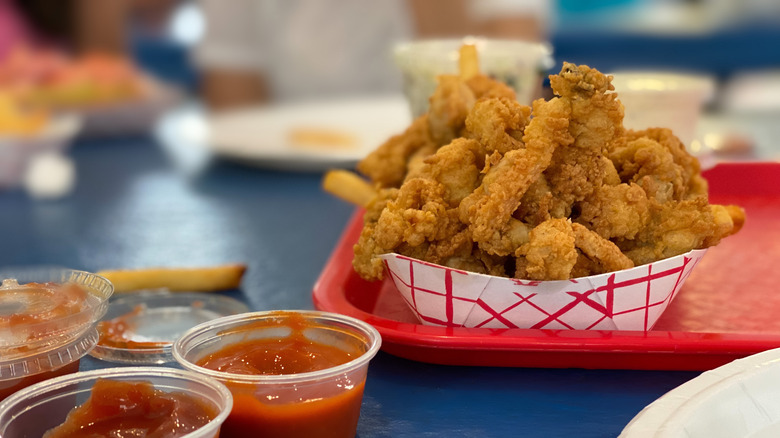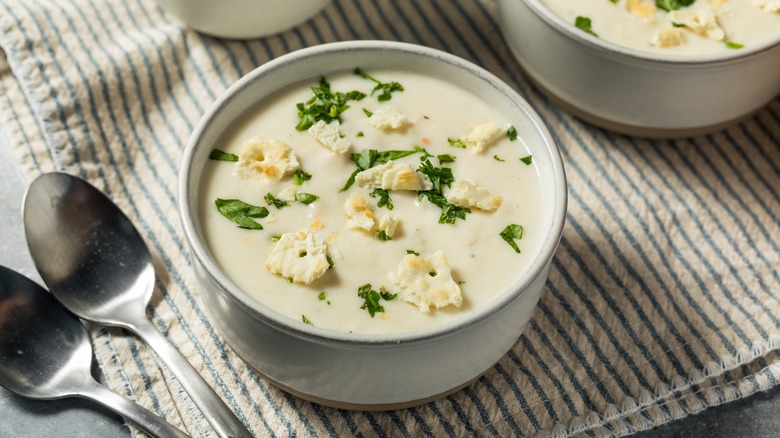Soft Shell Clams Vs Hard Shell Clams: What's The Difference?
There's a lot to like about clams. They are among the most affordable types of seafood and have some of the lowest mercury levels among seafood. Clams are also a very versatile ingredient. They're great steamed, baked, boiled, and fired, in soup, on pasta, or all by themselves with a generous helping of garlic butter. A key factor in the culinary versatility of these mollusks is the fact that there are a few different species of clam, each lending itself to certain preparations. Picking the right clams for the job is essential to a successful meal.
There are primarily seven species of clam sold in the United States. On the West Coast, you'll find the Pacific species of razor clams, Manila clams, and the famously huge geoduck clam. On the East Coast, you'll find surf clams and jackknifes, but none of these varieties are quite as common as hard shell and soft shell clams. Hard shell and soft shell sound like generic descriptors, but they actually refer to two specific species of clam. You're quite likely to encounter these at some point, especially if you live on the East Coast, so let's get the differences straight, because the names of these species aren't really very useful.
What are soft shell clams?
Soft shell clams refer to the species Mya arenaria, which can be found mainly along the northeast coast of the United States. You might assume that soft shell clams are like soft shell crabs in that their shell is soft and therefore edible, but in reality, the name isn't so straightforward. Soft shell clams have thin shells, but they aren't really soft to the touch. They are actually quite brittle, and you can find traces of the crumbled shells in the sand where these clams are harvested. The other key feature of soft shell clams is that they have very large necks (technically known as siphons), so large, in fact, that the clams cannot fully close their shells.
You might find soft shell clams sold under a few different names. They are commonly called steamers, since steaming is a particularly popular way to prepare them. They are also known as Ipswich clams, after the coastal town in Northern Massachusetts where they are particularly abundant. These clams are about 2 inches wide when fully mature, and spend their time buried in sandy tidal zones. If you go hunting for soft shells on the beach, you may spot them by the small jets of water they squirt up from their burrows in the sand. This characteristic has earned soft shell clams their most colorful nickname, pisser clams, though you probably won't see that on many menus.
What are hard shell clams?
Hard shell clams refer to the species Mercenaria mercenaria, also known as quahogs. They can be found in the same northeastern waters as soft shell clams. Their shells are thicker than those of soft shell clams, and they have a study quality, unlike the brittle nature of their counterparts. Hard shell clams do not bury themselves as deep in the sand as soft shell clams do, so their siphons do not need to be as long. With smaller siphons, hard shell clams are able to fully seal their shells.
Hard shell clams are sold under different names depending on their size. The smallest hard shells, typically around an inch and a half wide, are called littlenecks. The next size up is called the middleneck or topneck, and they are about 2 inches wide each. Moving upwards, you have "cherrystones," clams that are about 2½ inches wide. Lastly, you have the largest type of hard shell clam, "chowder" clams, which top 3 inches in width (additionally, the word "quahog" is often used specifically to reference chowder clams).
The best ways to cook and eat soft shell clams
If you want a tip for cooking soft shell clams, look no further than their most common nickname, "steamers". The most popular way to prepare this type of clam is by steaming them in water or beer. Once they are fully cooked, drain the clams, but save the liquid. Traditionally, steamers are served with a warm cup of steaming broth on the side, but not for the reason you might think. Due to the fact that soft shell clams cannot close their shells completely, they tend to have a bit of sand lodged in them. To deal with this, diners pick the clams out of their shells and swirl them around in the steaming liquid to wash off any excess sand before dunking the meat in melted butter and feasting.
Aside from steaming, the other main way in which you'll see soft shell clams cooked is by frying them. This is the fashion at many clam shacks in New England, particularly around Ipswich, where the popularity of fried soft shell clams has helped make the town's name synonymous with this species. Frying soft shell clams can be tricky, as they can become tough if fried for too long, but if done right, with a corn flour dredge, they have the perfect balance of crispy coating and tender meat.
The best ways to cook and eat hard shell clams
Hard shell clams are more versatile than soft shell clams when it comes to the kitchen, but the best cooking method depends on the size of hard shell clam you choose. Generally speaking, the bigger the clam, the tougher the meat will be. Littleneck, middleneck, and cherrystone clams are all good for enjoying raw on the half shell. Littlenecks are the best hard shell clams to use for steaming, while middleneck and cherrystone clams go great on the grill. Cherrystones are also a particularly popular choice for spaghetti alle vongole, or spaghetti with clams.
Chowder clams are more difficult to cook with simply because they are so big and their flesh is consequently rather tough. These clams can weigh half a pound each or more, and they need to be chopped into bite-sized pieces before cooking. The best way to use chowder clams is just as their name suggests, by whipping up a batch of creamy clam chowder or bisque.
